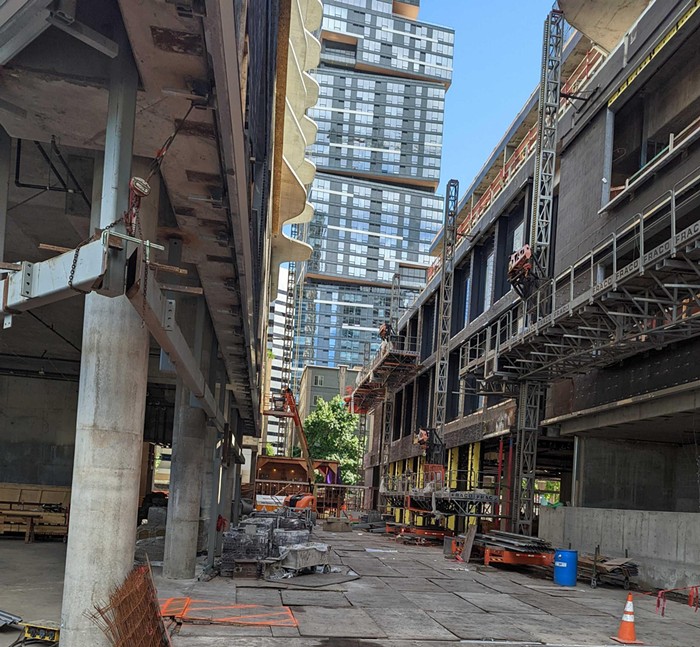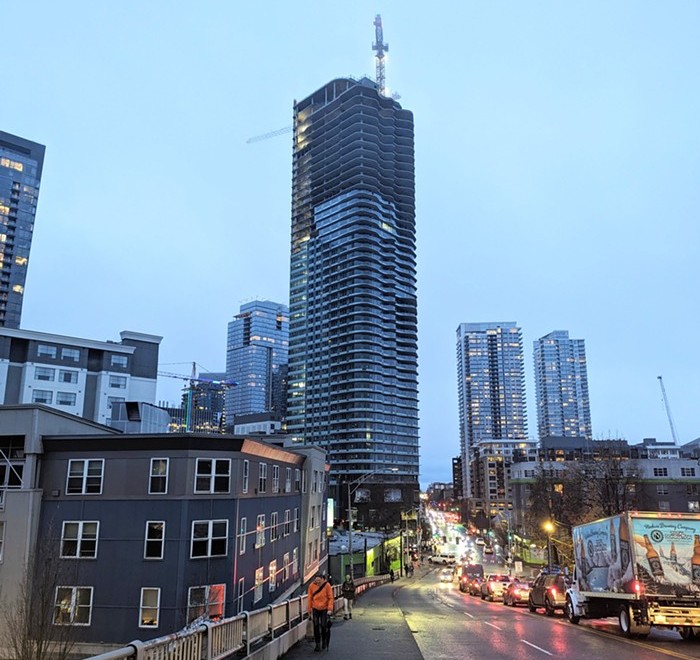Shortly before construction began on the Madison & Boylston tower in 2020, a headline in Capitol Hill Seattle Blog described the project as the "first affordable high rise in Seattle in more than 50 years." (Yes, it took that fucking long; and, yes, it really is affordable.) The 17-story tower, jointly developed by Bellwether Housing and Plymouth Housing Group, is on a property Sound Transit claimed in 2001 to build a First Hill subway station. That excellent plan was abandoned because all public transportation projects do not hold a candle to projects devoted to the impossible task of improving the experience of a space- and resource-exhausting form of transportation, the ultra-costly car. Obstacles met by the latter are, for reasons that are obvious (endless capitalist growth), always far less opposing than those met by the former. And so a rational multi-modal International District can be stopped; but a tunnel (State Route 99) doomed from the get-go to solve nothing could not.
Budgeted at around $60 million, and designed by the local architectural firm Weber Thompson (more about that in a moment), the Madison & Boylston project answers a question that KUOW's Bill Radke posed to me in a recent episode of Words In Review: "As you know a lot of people in Seattle want homes to be cheaper. Can a residential building be a work of art and still be affordable?"
Congrats to @bw_housing & @PlymouthHousing for groundbreaking on their Madison/Boylston building! This innovative partnership will bring over 350 homes to the First Hill neighborhood. Watch the groundbreaking video here:https://t.co/9eTsx1yPBM
— Office of Housing (@seattleoh) October 27, 2020
My answer? Yes! It is nothing but nuts that public housing projects in the past were strapped for cash. In the 1950s, for example, Seattle's most famous architect, Minoru Yamasaki, had to cut so many corners in the design of a housing project, Pruitt–Igoe. The building's demise/demolition in 1972 was dramatically described by critic Charles Jencks as "the day Modern architecture died." The budget constraints imposed on Yamasaki had little to do with scarcity (in the original or trans-historical sense), but instead reproduced a class order that was, in essence, cultural and, in time, historically specific.
As there are language games, there are, more importantly, scarcity games. The latter we call economics, which is, as Lionel Robbins explained in the early 1930s (PDF), "the science which studies human behaviour as a relationship between ends and scarce means which have alternative uses." This definition is with us even today. It's found in every attempt to cut welfare programs, to reduce government deficits, and impose austerity. Its function, as Moishe Postone pointed out in his 1993 masterpiece Time, Labor, and Social Domination, is to deliberately confuse two forms of wealth: one that concerns materials (or stuff—or stoff) with one that concerns immaterial value, which is an abstraction made all too real by what the young Danish philosopher Søren Mau recently described as "mute compulsion." But what this theorist left out in their otherwise superb book is that its cultural constituted scarcity that makes the abstraction of mute compulsion "a regulating natural-law, just as [real as] the law of gravity... when the house falls down on one’s head."
Floors 2-5 of Madison & Boylston "will offer 115 studios for seniors who have experienced chronic homelessness." And floors 6-17 "will offer 250 homes, ranging from studios to three-bedrooms." Nevertheless, the design of this building (its concept, its organization of materials, its particularities in relationship with the universality of modernism) is considerably better than most of the market-rate developments found in much of Capitol Hill, near Roosevelt Station, around Columbia City, and so on. Let's not even speak of that monstrosity in Ballard that replaced the dream of the monorail station, Urbana. The architectural firm Weber Thompson did not sacrifice the art of the building for the kind of practical, meat-and-potatoes urbanism that Bill Radke, whose thinking is locked in the scarcity mode that defines orthodox economics, not only supports but sees as the heart of the Pacific Northwest spirit.
Indeed, during the UK's post-war (short-lived—a decade) submission to the humanist principles of social democracy, the art of the many housing projects far surpassed those in the market. This fact was made public by the greatest urban theorist of the 20th century, Ruth Glass, in a 1964 essay "London: Aspects of Change" which first presented the world with a word that has since gone global, "gentrification."
The large programme of urban reconstruction and rebuilding since World War II has had the result of reducing the contrasts between rich and poor districts within the boundary of the present County. Indeed, some of the conventional distinctions have been reversed, the new homes of working-class and lower-middle-class people, who are municipal tenants, are frequently superior in design and appearance to the older luxury flats and expensive houses of private tenants or owner-occupiers. Local authority housing and ancillary schemes have so much improved the looks and amenities of several districts—in sections of Paddington, Kensington, Westminster and elsewhere—that private developers have been prompted to renovate adjacent streets.
Please re-read the end of the last sentence. Please read the whole paragraph again. Please make Bill Radke read everything Ruth Glass has written. Gems of this kind are found in her work, which makes nonsense of market rationality. A society that checks the fiction of cultural scarcity, and thereby diminishes the power of wealth as value, and its concomitant mute compulsion, can expect social and affordable housing that's as good as—and often surpasses—what we find on the corner of Madison and Boylston today.
I will end with some thoughts from the person behind Buildings of Seattle, Keith Cote. He recently identified Weber Thompson's downtown apartment buildings, most of which rose during the tech boom of the previous decade, with barcode architecture.
It is also interesting to see that Weber Thompson has moved on from their barcode style with [the Madison/Boylston] tower. I really like textured brick banding at the base of the tower, but the use of spandrel glass is uninventive like many other contemporary highrises. That aspect is at least an improvement over the dated Danforth on the same block... It is also interesting that there is no visible "cheapness" in the design of this affordable apartment in relation to other contemporary projects. This either means that WT stepped up their design here or that developers/architects for luxury/ market rate apartments have been getting by with the bare minimum as we always suspected.
















